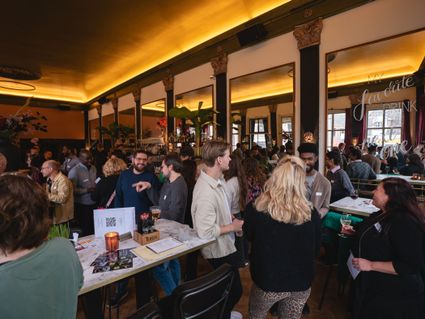Learn ways to meet the Dutch and connect with them!
Gezellig
The Dutch love their social gatherings to be ‘gezellig’. In fact, some consider this word to describe the heart of Dutch culture. As the term is hard to translate, let us give you some examples of its use:
- A room, restaurant, or café can be gezellig (meaning 'cozy' or 'inviting').
- A person can be gezellig (meaning 'entertaining' or 'pleasant', 'convivial' or 'sociable').
- A party can be gezellig (meaning 'fun').
- A visit to one's grandparents can be gezellig (meaning 'togetherness').

Planning and punctuality
The Dutch live by their agendas. They are very time-conscious and organized, so scheduling is important to them, as is being punctual. Being late is not appreciated, especially without informing, even when it concerns a casual appointment.
When someone invites you, it is always a good idea to ask what time you are expected. The Dutch generally call in advance to make an appointment with friends. It is not very common to just drop by. Even going out for lunch or to see a film with a Dutch friend may need planning several days or even weeks ahead. You can imagine that planning a get-together with multiple Dutch people who all have busy agendas can be quite a challenge. To plan a group event, the Dutch like to use the website datumprikker.nl to find a suitable date.
Birthdays
When it is your birthday your colleagues might expect you to bring cake to work to share with them. At primary school, a small celebration is held for each pupil’s birthday (small to us, but of huge importance to the child). This usually involves the birthday boy or girl wearing a large paper crown while the classmates sing birthday songs. The birthday kid is expected to bring treats (‘traktaties’) to school to share with the classmates and in some cases separate treats to hand out to all of the school’s teachers. Some schools only accept healthy treats, so it’s best to check with the teacher. The treats for the classmates tend to involve some degree of home-assembly and preparation. For ideas, google the terms ‘traktaties’, ‘gezonde traktaties’ (healthy treats) or ‘makkelijke traktaties’ (easy-to-make treats).
If you are invited to someone’s birthday party at their home, you might be surprised to find the seating arrangement resembles that of a doctor’s waiting room: lots of chairs in a big circle. Start by greeting and congratulating (‘Gefeliciteerd!’) the person whose birthday it is and then make your way past every person in the circle, greeting them and congratulating them as well. (The Dutch will also congratulate you on someone else’s birthday.) If you come across anyone in the circle that you haven’t met before, introduce yourself by stating your name and, if you wish, an explanation of your relation to the birthday person (‘I am Frank’s colleague/neighbor’ etc). Take a look here for more information.
How to Dress
The Dutch are usually casual dressers, often keeping mind practicality and comfort in their choice of outfit. Even in many office settings, the dress code can lean more towards business casual than formal. Looking the part is important, though most Dutch people prefer not to draw too much attention with their outfits. The Dutch weather also influences the style of outfit, with many people wearing warm waterproof jackets regularly during their commutes to and from work, especially when their mode of commute is via bicycle. The autumn and winter seasons in the Netherlands can also be quite cold, so it's important to make sure that you own some clothes suited for the colder or wetter weather, especially if you plan on cycling frequently.
Although many social and work environments encourage casual or business casual dressing, it's important to note that this is not always the case, so if you are in doubt about the dress style at your work place or at an event, don't hesitate to ask.



